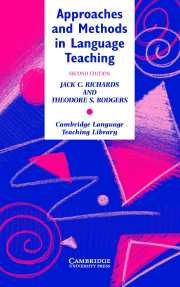Book contents
- Frontmatter
- Contents
- Preface
- Part I Major language trends in twentieth-century language teaching
- Part II Alternative approaches and methods
- 5 Total Physical Response
- 6 The Silent Way
- 7 Community Language Learning
- 8 Suggestopedia
- 9 Whole Language
- 10 Multiple Intelligences
- 11 Neurolinguistic Programming
- 12 The lexical approach
- 13 Competency-Based Language Teaching
- Part III Current communicative approaches
- Author index
- Subject index
9 - Whole Language
Published online by Cambridge University Press: 06 July 2010
- Frontmatter
- Contents
- Preface
- Part I Major language trends in twentieth-century language teaching
- Part II Alternative approaches and methods
- 5 Total Physical Response
- 6 The Silent Way
- 7 Community Language Learning
- 8 Suggestopedia
- 9 Whole Language
- 10 Multiple Intelligences
- 11 Neurolinguistic Programming
- 12 The lexical approach
- 13 Competency-Based Language Teaching
- Part III Current communicative approaches
- Author index
- Subject index
Summary
Background
The term Whole Language was created in the 1980s by a group of U.S. educators concerned with the teaching of language arts, that is, reading and writing in the native language. The teaching of reading and writing in the first language (often termed the teaching of literacy) is a very active educational enterprise worldwide, and, like the field of second language teaching, has led to a number of different and at times competing approaches and methodologies. One widespread approach to both the teaching of reading and writing has focused on a “decoding” approach to language. By this is meant a focus on teaching the separate components of language such as grammar, vocabulary, and word recognition, and in particular the teaching of phonics. Phonics is based on the theory that reading involves identifying letters and turning them into sounds. Other reading theories approach reading through skills. The Whole Language movement is strongly opposed to these approaches to teaching reading and writing and argues that language should be taught as a “whole.” “If language isn't kept whole, it isn't language anymore” (Rigg 1991: 522). Whole Language instruction is a theory of language instruction that was developed to help young children learn to read, and has also been extended to middle and secondary levels and to the teaching of ESL. “What began as a holistic way to teach reading has become a movement for change, key aspects of which are respect for each student as a member of a culture and as a creator of knowledge, and respect for each teacher as a professional” (Rigg 1991: 521).
Information
- Type
- Chapter
- Information
- Approaches and Methods in Language Teaching , pp. 108 - 114Publisher: Cambridge University PressPrint publication year: 2001
